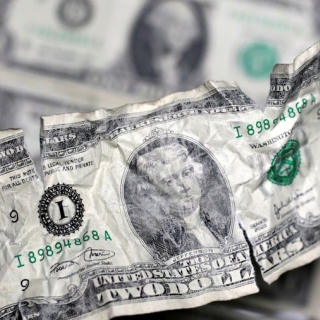


The dollar fell for a third day against a range of currencies on Wednesday, after U.S. President Donald Trump failed to convince Republican holdouts to back his sweeping tax bill.
Traders were also wary of U.S. officials potentially angling for a weaker dollar at Group of Seven finance minister meetings under way in Canada.
Developments in Trump's global tariff war, which have swung currencies wildly in recent months, have slowed considerably this week, even as the clock ticks to the end of a 90-day tariff respite for U.S. trade partners in the absence of new deals.
While markets remain optimistic that the White House is eager to get trade flowing again on a sustained basis, talks with close allies Tokyo and Seoul appear to have lost momentum.
All this has combined to keep the dollar under pressure and U.S. Treasury yields rising, as the "sell America" theme continues to inform investment decisions, if in a less dramatic fashion than earlier this month.
"We do not consider the USD - and U.S. assets generally - are at the start of a 'death spiral'," Commonwealth Bank of Australia analysts wrote in a note.
"However, we forecast the USD to re‑weaken in 2026 once the tariff uncertainty fades and lower interest rates support a recovery in the world economy," they said. "Additionally, we expect large money managers to allocate less capital to USD assets over time."
A Moody's downgrade of the U.S. sovereign debt rating on Friday may have had only a limited impact on markets, but it has added to the narrative of less faith in U.S. assets as safe havens. As a result, the dollar is down on the year against every major currency .
Trump's tax bill would add $3 trillion to $5 trillion to the country's debt, according to nonpartisan analysts. Ballooning fiscal debt, trade frictions, and weakened confidence have weighed on U.S. markets.
"Tariff rates are now lower, but not low, and the same can be said about recession risks in the U.S.," Goldman Sachs analysts wrote in a research note.
"The U.S. still faces the worst growth-inflation mix of the major economies, and as the fiscal bill makes its way through Congress, eroding U.S. exceptionalism is proving - literally - costly at a time of large funding needs."
An auction of 20-year Treasuries later might offer a litmus test of investor appetite for long-dated U.S. debt.
Japanese Finance Minister Katsunobu Kato said ahead of an expected meeting with U.S. Treasury Secretary Scott Bessent that talks on exchange rates would be based on their shared view that excessive volatility is undesirable.
"While market participants do not expect any explicit comment from Bessent on a shift in Washington policy on the dollar, any sign of pushing trading partners in Asia ... to conducting less or stopping U.S. dollar-buying intervention would likely trigger further big moves weaker for the dollar," MUFG strategist Derek Halpenny said.
The yen strengthened against the dollar, which fell 0.6% to 143.595 yen, extending gains derived in part from a steep rise this week in domestic bond yields .
Source: Reuters
The dollar fell due to disappointing US jobs data, with layoffs reaching more than 150,000 in October, the highest in over 20 years. Another factor: the market is now considering the possibility that...
The US Dollar trims losses on Friday with investors wary of risk following another sell-off on Wall Street, as concerns of an AI bubble remain alive. The USD Index, which measures the value of the Dol...
The U.S. dollar edged up on Wednesday, extending its gains from last week on doubts about the outlook for another Fed rate cut this year and as private payrolls data assuaged worries over the state of...
The US dollar held near a three-month high on Tuesday (November 4th) as a divided Federal Reserve prompted traders to reduce their bets on a rate cut, while the Japanese yen strengthened after a verba...
The US dollar held near a three-month high on Monday (November 3rd) ahead of economic data this week that will provide only vague clues about the health of the US economy and could reinforce the Feder...
Crude prices recovered from a midday dip on Friday on hopes Hungary can use Russian crude oil as U.S. President Donald Trump met Hungary's Prime Minister Viktor Orban at the White House. Brent crude futures settled at $63.63 a barrel, up 25 cents...
US stocks rebounded from early losses to close mostly higher on Friday amid hopes that Congress members were making progress toward ending the government shutdown. The S&P 500 and the Dow Jones closed 0.3% higher, while the tech-heavy Nasdaq...
European stocks fell on Friday as investors digested more quarterly earnings, but weekly losses were inevitable, with concerns regarding overheated valuations evident. The DAX index in Germany dropped 0.8% and the CAC 40 in France declined 0.2%,...
 The U.S. Supreme Court's tough questioning of President Donald Trump's global tariffs has fueled growing speculation that they will be overturned,...
The U.S. Supreme Court's tough questioning of President Donald Trump's global tariffs has fueled growing speculation that they will be overturned,...
 European stocks opened lower on Thursday, as investors reacted to another flurry of corporate earnings.
The pan-European Stoxx 600 was 0.3% lower...
European stocks opened lower on Thursday, as investors reacted to another flurry of corporate earnings.
The pan-European Stoxx 600 was 0.3% lower...
 European stocks fell on Friday as investors digested more quarterly earnings, but weekly losses were inevitable, with concerns regarding overheated...
European stocks fell on Friday as investors digested more quarterly earnings, but weekly losses were inevitable, with concerns regarding overheated...
 Two weeks before the US Federal Reserve's final meeting, with the federal government's data taps closed, Atlanta Fed staff bolstered their economic...
Two weeks before the US Federal Reserve's final meeting, with the federal government's data taps closed, Atlanta Fed staff bolstered their economic...